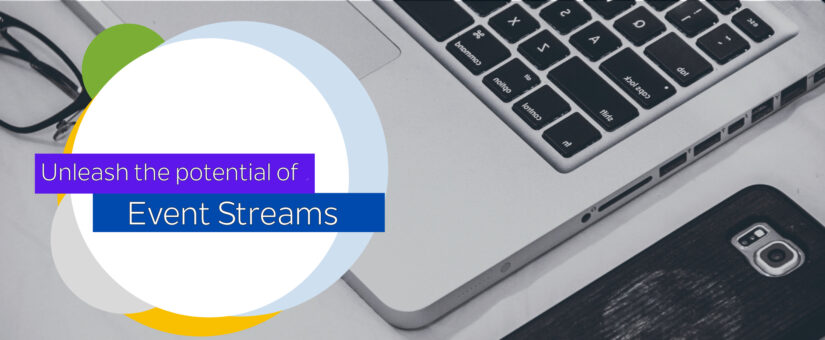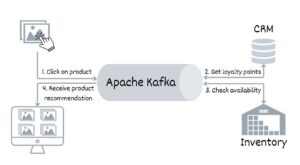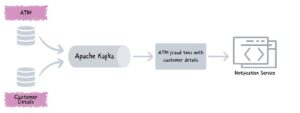
Unleash the Potential of Event Streams: A Game-Changer in Software Engineering
- Posted by Salma El-Zeky
- On December 21, 2023
In today’s data-driven world, the sheer volume of data being generated every day is growing at an exponential rate. Whether it’s data from sensors, user interactions on a website, or internal system events, our applications are expected to handle this continuous influx of new events. So, can we architect our applications in a way that not only handles this data but also puts events at the very core of our systems? And what benefits can this architectural approach bring?
In this blog, we’ll delve into these questions, exploring the concept of event-driven architecture (EDA) and how it places events at the heart of system design. Additionally, we’ll investigate several significant advantages that come with implementing this architectural pattern.
Introduction: Event Streams and their Importance in Microservices Architecture
The Evolution of Microservices Architecture
Microservices have fundamentally transformed the landscape of modern software systems. They’ve encouraged us to break down those massive monolithic applications into smaller, more independent components. This paradigm shift has empowered us with superpowers like flexibility, scalability, and easier maintenance. However, as microservices took the spotlight, they also brought along some new challenges, like managing how these services communicate with each other and ensuring our data stays in sync.
Introduction to Event Streams
Think of event streams as a powerful way for services to communicate and share data in a microservices world. They allow real-time sharing of events among these services, making them incredibly adaptable and flexible. Event streams empower services to independently respond to events and update their state accordingly, fostering a highly flexible and scalable system.
Understanding Event Streams: Definition and Key Concepts
What are Event Streams?
Imagine event streams as a diary of events happening in your microservices setup. Each event marks something significant, like a new user signing up or an order being placed. These events are published to the event stream, where interested services can subscribe, respond, and evolve autonomously.
Key Concepts and Components of Event Streams
Event streams consist of a few essential components: the event producer that generates and publishes events to the stream, and the event consumer, which listens in and takes action based on those events. The stream acts as the central hub, ensuring events are delivered reliably and in the right order.
Advantages of Event-Driven Architecture
True Decoupling of Producers and Consumers
EDA achieves genuine decoupling between system components, effectively separating data ownership by domain. This separation enables a logical division between event production and consumption, offering benefits such as:
• Producers no longer need to worry about how their events will be consumed, allowing additional consumers to join without affecting the producers.
• Consumers remain oblivious to the event’s origin.
This loose coupling makes it possible to implement microservices in various languages and technologies, tailored to specific tasks. The format of event data becomes irrelevant, whether it’s JSON, XML, Avro, or others. Moreover, it enables effortless scaling and dynamic addition or removal of event producers and consumers, making system expansion a breeze.
Resiliency of Event Streaming Systems
The loose coupling in EDA means services do not need to be concerned about the health or status of other services. This inherent decoupling contributes to system resiliency:
• If one microservice fails, the application can continue running in its absence, thanks to events being stored in the messaging backbone.
• Asynchronous event streaming plays a pivotal role in this resiliency. Events are published as they occur, and services consume them as an unbounded stream.
Failures can be gracefully handled, with services picking up where they left off and, if needed, replaying any missed events.
Push-Based Messaging
EDA facilitates push-based messaging, eliminating the need for clients to continuously poll for updates. Clients can receive event updates as they happen, streamlining processes for on-the-fly data transformation, analysis, and data science tasks. This approach is particularly powerful for real-time applications and is beneficial in scenarios with edge devices that may experience intermittent connectivity.
Challenges and Considerations for Event Streams in Microservices
Event Ordering and Consistency
One of the primary challenges when dealing with event streams in microservices architecture is ensuring event ordering and consistency. In scenarios where multiple services produce and consume events concurrently, maintaining the correct processing order is crucial. This challenge necessitates careful consideration and the implementation of mechanisms like event versioning and distributed consensus algorithms to ensure event ordering and consistency.
Data Serialization and Compatibility
Another challenge arises when different services in a microservices ecosystem need to communicate through event streams. These services may be developed using different programming languages or frameworks, potentially leading to data serialization and compatibility issues. To address this, establish a well-defined data schema and use standardized serialization formats like JSON or Protocol Buffers to ensure seamless communication. Additionally, consider backward compatibility to handle updates and changes to the event data structure without disruptions.
Monitoring and Debugging of Event Streams
Monitoring and debugging event streams can be challenging within microservices architecture. Proper tools and processes are essential to track event journeys, detect bottlenecks, and troubleshoot issues effectively. Employ logging, tracing mechanisms, and centralized monitoring tools to gain visibility into the event stream, identify performance problems, and ensure smooth event processing across services.
Real-World Use Cases: Success Stories of Event Streams in Microservices Architecture
Event-Driven E-commerce Platform
Consider an e-commerce platform where inventory management, order processing, and payment services need seamless communication. Event streams enable real-time event exchange, ensuring accurate inventory updates, timely order processing, and coordinated payment transactions. This event-driven architecture enhances scalability, fault tolerance, and system flexibility, delivering a seamless shopping experience for customers.

Fraud Detection System with Event Streams
In a fraud detection system, event streams play a pivotal role in identifying and preventing fraudulent activities in real-time. By analyzing events like user logins, financial transactions, and suspicious behavior patterns, machine learning algorithms can detect potential fraud. Leveraging event streams, these detection algorithms consume and analyze events as they occur, enabling timely alerts and blocking of fraudulent activities.

Conclusion: Embracing the Future with Event Streams
In conclusion, event streams are changing the game in microservices architecture. They’re the key to efficient and reliable communication between services, giving developers the power to create flexible and responsive systems. Embracing event-driven architecture with event streams opens up exciting possibilities for real-time data processing, smart analytics, and seamless integration of microservices.
Ride the wave of event streams and revolutionize your software engineering journey!




